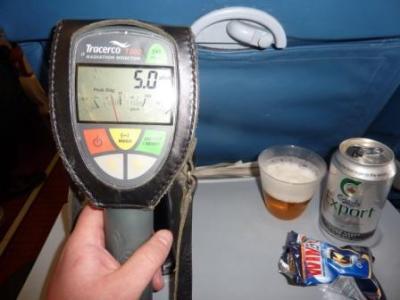Radiation exposure to passengers of commercial aircraft
Published: Sep 29, 2021
This rule of thumb could be used as a risk comparison when considering exposures from other environmental radiation sources or occupational exposure. It might also be useful if considering medical exposure risks.
The dose rate from radiation resulting from the interactions of cosmic radiation with the upper atmosphere is well documented. The secondary radiation arising from these interactions is measurable in commercial aircraft at cruising altitude (typically 40,000 feet). The measurable dose rate will be dependent on altitude and latitude. The dose rate, for a given altitude will be maximum at the North & South Pole, and minimum at the equator (so is dependent on latitude).
The rule of thumb dose rate is 5 micro Sv/h at 40,000 feet (UK latitude)
Here is a real measurement taken above the UK (above the City of Manchester).

The monitor used in the above picture contains a small GM tube and so will not, for example, detect neutrons. In fact the secondary radiations are a cosmic soup of x-rays, muons, protons, alpha particles, electrons, neutrons etc. However, everything is relative so the measurements with a simple dose rate monitor give good values for comparison, we are not trying to measure this radiation analytically.
